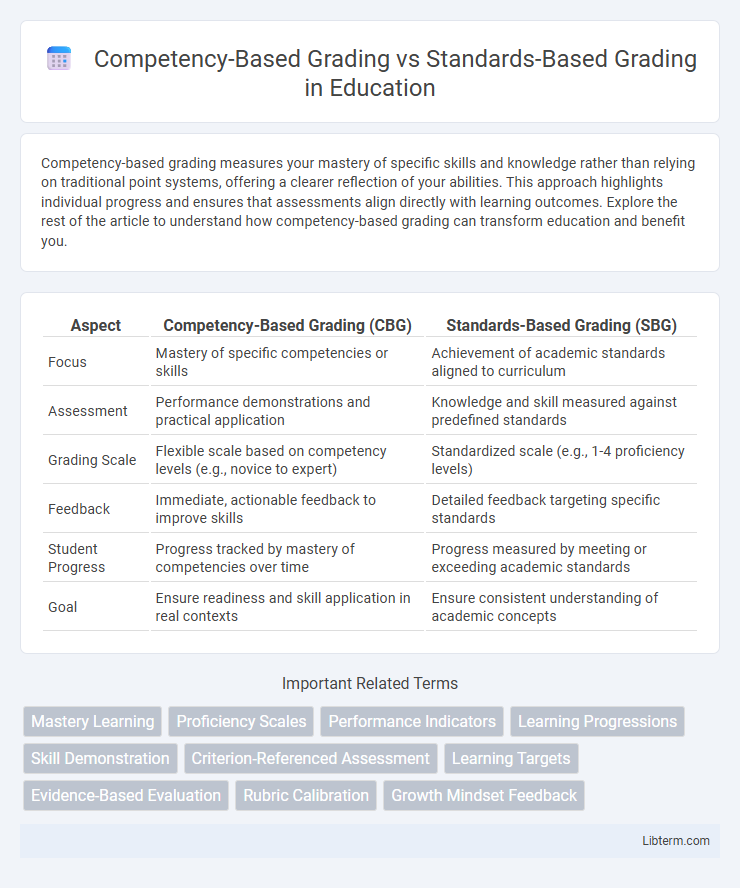Competency-based grading measures your mastery of specific skills and knowledge rather than relying on traditional point systems, offering a clearer reflection of your abilities. This approach highlights individual progress and ensures that assessments align directly with learning outcomes. Explore the rest of the article to understand how competency-based grading can transform education and benefit you.
Table of Comparison
| Aspect | Competency-Based Grading (CBG) | Standards-Based Grading (SBG) |
|---|---|---|
| Focus | Mastery of specific competencies or skills | Achievement of academic standards aligned to curriculum |
| Assessment | Performance demonstrations and practical application | Knowledge and skill measured against predefined standards |
| Grading Scale | Flexible scale based on competency levels (e.g., novice to expert) | Standardized scale (e.g., 1-4 proficiency levels) |
| Feedback | Immediate, actionable feedback to improve skills | Detailed feedback targeting specific standards |
| Student Progress | Progress tracked by mastery of competencies over time | Progress measured by meeting or exceeding academic standards |
| Goal | Ensure readiness and skill application in real contexts | Ensure consistent understanding of academic concepts |
Understanding Competency-Based Grading
Competency-Based Grading evaluates students based on their mastery of specific skills or competencies rather than traditional letter grades or percentages, ensuring personalized learning progress. This method provides clear benchmarks and detailed feedback, helping learners identify strengths and areas for improvement. Emphasizing mastery over time, Competency-Based Grading aligns assessment with real-world skill application and promotes deeper understanding.
What is Standards-Based Grading?
Standards-Based Grading (SBG) evaluates student performance based on mastery of specific learning objectives or standards, rather than overall points or averages. It provides detailed feedback on individual skills and knowledge areas, allowing educators to identify strengths and gaps in student learning more precisely. SBG emphasizes growth and understanding over time, promoting a clearer connection between instruction and assessment outcomes.
Key Differences Between Competency-Based and Standards-Based Grading
Competency-Based Grading assesses student performance based on the mastery of specific skills or competencies, emphasizing the application and practical use of knowledge in real-world contexts. Standards-Based Grading measures student achievement against predefined academic standards, focusing on content knowledge and understanding aligned with curriculum benchmarks. While competency-based approaches prioritize personalized progress and skill development, standards-based systems emphasize uniform performance criteria and consistent evaluation across all students.
How Competency-Based Grading Works in Practice
Competency-Based Grading operates by assessing students' mastery of specific skills or competencies, rather than accumulating points from various assignments. Students demonstrate their understanding through personalized tasks, projects, or assessments aligned with defined learning outcomes, allowing for multiple attempts to achieve proficiency. Progress is tracked through detailed performance indicators, enabling educators to provide targeted feedback and support tailored to each student's individual learning pace.
The Core Principles of Standards-Based Grading
Standards-Based Grading centers on assessing students' mastery of clearly defined learning objectives rather than accumulating points or percentages. It emphasizes clear, consistent criteria for performance levels, providing detailed feedback to guide student growth and understanding. This approach promotes transparency, encourages student self-assessment, and aligns grading with educational standards to ensure equitable evaluation of knowledge and skills.
Benefits of Competency-Based Grading for Students
Competency-Based Grading (CBG) offers personalized learning by allowing students to progress upon mastery of specific skills, ensuring a clear understanding rather than accumulation of points. It promotes motivation and self-awareness by highlighting individual strengths and areas for improvement, fostering deeper engagement with the material. Students benefit from transparent, objective assessments that provide actionable feedback essential for lifelong learning and skill development.
Advantages of Standards-Based Grading in Education
Standards-Based Grading (SBG) provides clear, specific feedback by measuring student performance against defined learning standards rather than broad competencies, enhancing transparency in student progress. This approach fosters targeted instruction and personalized learning by identifying precise areas of strength and weakness, supporting mastery and continuous improvement. SBG also reduces grade inflation and subjective bias, promoting equity by ensuring grades reflect actual academic achievement aligned with curriculum goals.
Challenges and Drawbacks of Both Grading Systems
Competency-Based Grading often faces challenges related to subjective evaluation and inconsistent criteria across educators, which can lead to variability in assessing student mastery. Standards-Based Grading struggles with communicating nuanced student progress to parents and stakeholders unfamiliar with detailed achievement levels, potentially causing confusion and misconduct of performance understanding. Both systems require significant teacher training and time investment to implement effectively, posing practical constraints in traditional school environments.
Implementation Strategies for Schools
Implementing competency-based grading requires schools to develop clear, measurable competencies aligned with curriculum goals and ensure consistent teacher training for accurate assessment. Standards-based grading implementation involves aligning report cards and grading scales with state or national standards, coupled with regular data review meetings to monitor student progress against benchmarks. Both approaches benefit from integrating digital tools to track performance and providing continuous professional development to support educators in maintaining grading fidelity.
Choosing the Right Grading System for Your Educational Goals
Competency-Based Grading emphasizes mastery of specific skills and knowledge, allowing students to progress at their own pace, while Standards-Based Grading measures achievement against predefined learning standards, providing clear benchmarks for academic performance. Selecting the right grading system depends on your educational goals: Competency-Based Grading supports personalized learning paths and continuous assessment, ideal for fostering deep understanding and skill development. Standards-Based Grading offers transparency and consistency in performance evaluation, making it effective for aligning instruction with curriculum standards and communicating learning outcomes to stakeholders.
Competency-Based Grading Infographic

 libterm.com
libterm.com